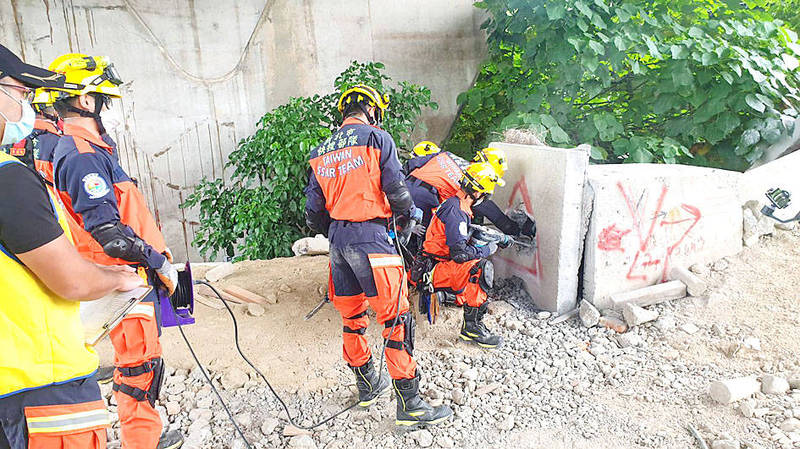《TAIPEI TIMES》Taiwan’s seismic activity has risen this year: CWB

Search-and-rescue trainees from the New Taipei City Fire Department’s Zhuwei Precinct take an evaluation test yesterday. The city is establishing search-and-rescue teams to help extricate people trapped under rubble after earthquakes. Photo courtesy of the New Taipei City Fire Department
UP SIDE: Yesterday’s 5.9 earthquake was felt nationwide, but no casualties were reported and the Seismological Center’s director said that aftershocks were unlikely
By Shelley Shan / Staff reporter
A magnitude 5.9 earthquake struck off Taiwan’s east coast at 3:24am yesterday, the Central Weather Bureau said, adding that the nation has seen more active and frequent seismic activity this year.
The hypocenter of yesterday’s earthquake was 59.3km east of Hualien County Hall at a depth of 17.9km, data collected by the bureau’s Seismological Center showed.
The earthquake was felt nationwide, with the largest intensity reaching level 4, the bureau said.
No casualties were reported as of press time last night.
Residents on the east coast are still recovering from severe infrastructure damage caused by a magnitude 6.8 earthquake on Sept. 18.
Yesterday’s earthquake was caused by the Philippine Sea Plate subsiding into the Eurasian Continental Plate, Seismological Center Director Chen Kuo-chang (陳國昌) said, adding that it was not related to the Sept. 18 quake.
However, the epicenter of yesterday’s earthquake was almost in the same region as that of a magnitude 6.06 earthquake on Jan. 3, Chen said.
Since 1973, only 25 earthquakes exceeding magnitude 5.5 at a depth of less than 30km have been detected in that region, eight of which exceeded magnitude 6, Chen said.
The biggest one that occurred in the region was a magnitude 6.8 earthquake on March 31, 2002, he said.
Construction on the Taipei 101 building was suspended as a crane on the building’s roof fell after the quake, killing five workers and damaging multiple vehicles, Chen said.
While certain locations, such as Taipei’s Xinyi District (信義), are far from the epicenter, residents tend to experience intense shaking due to seismic site effects, in which seismic waves are amplified in superficial geological layers, he said.
Although yesterday’s earthquake nearly reached magnitude 6, it is not likely to trigger many aftershocks, Chen said.
“The earthquake occurred in a geologically fragmented zone, so aftershocks should occur quickly afterward. Our estimate is that no aftershock will occur if nothing happened the day after the earthquake. If there is an aftershock, it could reach magnitude 4.5 or greater,” he said.
Chen said that aftershocks triggered by the earthquake on Sept. 18 have shown signs of gradually subsiding, although the bureau still recorded four aftershocks on Monday, which was “unusual.”
Seismic activity around Taiwan proper has been more active and frequent this year, Chen said.
Taiwan has an average of two or three earthquakes exceeding magnitude 6 per year, but eight earthquakes larger than magnitude 6 have been recorded so far this year, he said.
“As of yesterday, 55 earthquakes of magnitude 5 to 6 had occurred this year. The average, however, is 24 to 25 per year,” Chang said, adding that more seismic activity is expected during the remainder of this year.
新聞來源:TAIPEI TIMES















